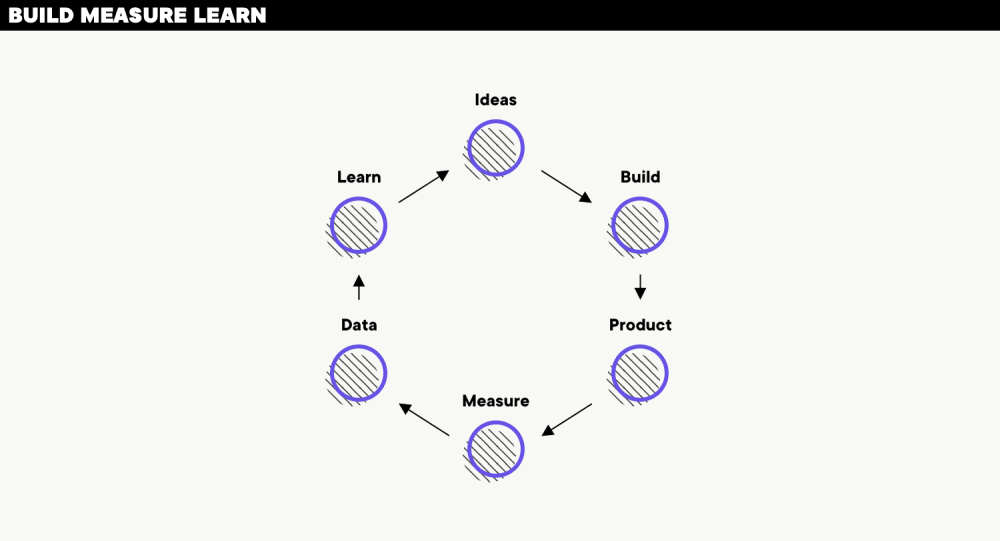Lean Startup Series: Innovation Accounting
Innovation accounting is a key element of the lean startup approach. Embodying the ‘measure’ and ‘learn’ elements of the Build-Measure-Learn cycle, innovation accounting enables business owners and developers to create useful metrics that offer insight into user engagement, product-market fit, and scalability.

Table of contents
You may have heard the phrase, “There’s no accounting for taste,” but when it comes to the lean startup approach to digital product development, there is accounting for innovation. And not only does it exist but it’s necessary. After all, a startup business environment is all about innovation and creativity – if you’re not aiming for something new, you’re not really a startup.
So we need some way to measure that. Especially considering that a startup is, by definition, a new venture – there are no existing metrics or data or past performance statistics to measure against. You’re starting from scratch and so must all your accounts.
>> See how scrum can boost your software development projects
In his book, “The Lean Startup”, Eric Ries defines innovation accounting as
…a way of evaluating progress when all the metrics typically used in an established company (revenue, customers, ROI, market share) are effectively zero.
In other words, a business developing a new product is surrounded by apparent ambiguity (how do you measure ‘opportunity’?) and innovation accounting brings a structure to measuring progress and success in that kind of environment. It’s about aligning your accounting with being in the business of new ideas.
What is innovation accounting?
The lean startup approach rests on five basic principles:
- Entrepreneurs are everywhere
- Entrepreneurship is management
- Validated learning
- Innovation accounting
- Build-Measure-Learn
Key to lean startup is learning and understanding – both the product and the client’s business. Lean startup innovation accounting is a structured way of measuring progress.
You can read about particular stages of lean startup full cycle product development here:
Traditional metrics, such as ROI or market share, are ill-suited to the startup business scenario. Ries emphasizes that the use of such measures only encourages exaggeration – either of the initial business plan or the predicted returns – in order to secure funding for the project. Besides, such metrics are not necessarily the measures of success here.

At the product development stage, is market share really such a concern? Yes, it’s important to know your target user, and yes, it’s a long-term goal to capture as many of those users as possible… but while you’re still building and testing your minimum viable product, the number of users is no indicator of success or failure; the product simply isn’t at that stage yet.
So, what does innovative accounting look like?
Leveling up – the 3 levels of innovation in accounting
Ries understands that metrics and measuring performance is often a tricky science and has suggested that three consecutive dashboards be developed for each product, each building on the last with further information and data.
Innovation accounting level 1: customer-focused
The key is to start with metrics that are not only easy to track but also relate to activities that are part of the digital product development process. Given that lean startup is all about understanding (and addressing) the needs of users, Ries encourages a customer focus for this first level. Examples might be
- Customer discussions (How many users do your business talk to each week?)
- Customer feedback (How many users provide feedback on the product each week?)
- Conversion rates (How many users have actually tried the product out?)
- Per Customer Revenue (How much would users be willing to pay for the product?)
The purpose here is to keep the process of development closely aligned with user needs and feedback. Metrics like these act as a measure of the level of involvement of users in your product development.
Innovation accounting level 2: making ‘Leap of Faith Assumptions’
Embarking on development of a new product for an untested market (at least, “untested” in relation to your product) is a leap of faith. What makes it so? The assumptions you’re making about the product and the market from the beginning.
>> Meet impact mapping - a method to help you manage goals, decide on priorities, and spot risks
The lean startup accounting approach implicitly acknowledges that it’s impossible to start building anything new without an assumption or two and measuring the truth of those assumptions is part of the second level of innovation accounting metrics.
Leap of faith assumptions come in two flavors: value assumptions about the value users will derive from the product, and growth assumptions about how new users will find your product. Testing these assumptions is at the center of the lean startup methodology through digital prototyping, MVP development, and validated learning exercises that guide the product’s development path.
Ries’ suggested value metrics aim to test for positive user behavior:
- Rate of repeat purchases
- Retention rates
- Willingness to pay a premium price
- Referral rates
Whereas the recommended growth metrics are looking for indications of sustainable growth:
- Word of mouth referrals
- Ability to take revenue from one customer and invest it into a new customer acquisition
- Ability to recruit new customers as a side effect of normal usage
The focus of this second level of metrics is to clarify the product scaling, and market fit.

Innovation accounting level 3: what’s the ‘Net Present Value’?
The beauty of Net Present Value (NPV) is that it’s a reality check. Your business plan (and forecasts) may aim for the product to be worth $X in 12 months’ time but NPV tells you what it’s worth now. Unlike more conventional NPV calculations that include assumptions around market size, market share, product cost, etc., the innovation accounting NPV is based on the long-term drivers of your product’s future performance (and value); for example:
- Number of website visitors
- Percentage of visitors that become users
- Percentage of users that choose to pay for the product (e.g. where there is a choice of freemium or paid versions available)
- Average price paid by each user
The purpose of level three is to shift the focus to the product’s financial performance.
Measuring the progress of your product
The key is that innovation accounting lean startup and its metrics are not static. The lean startup process rests on a constant spiralling cycle of Build-Measure-Learn. Not only is the product constantly improving but with every test or interaction, new data is being gathered. This gives the process a dynamism as the overall data provided by the metrics changes to take account of the latest input.
The implications of each new piece of data for your business can be seen instantly; the three dashboards offer a constantly updated picture of your product’s path to existence, and to market.

The innovation accounting process
A broad overview of how to adopt innovation accounting in your product development is as follows:
Choose your metrics
The key is to keep metrics simple and easy to use. If you’re wondering where to start, the above first level examples may provide an entry point. Or you can prompt ideas by asking yourself these questions and then refining the answers into metrics for which the data is available:
- Did we do what we said we would?
- How are people working differently?
- Do users see an improvement? (referring back to the original problem or need your product is an attempt to solve)
- What new sources of growth are we tapping?
Monitor the data
Apply your chosen metrics to the three levels, gather the data and measure progress.
Hold the project to account
Act on the data you have. Is the project team performing to plan? What progress is being made, and in what direction? Is the product development still aligned to identified user needs?
Benefits of innovation accounting
So far, so good. But what are the specific benefits of innovation accounting?
- The framework of metrics has a structure which means that each one is (if you’ve chosen wisely) essential. The three-level structure carries in-built dependencies in that the first measures user engagement, the second the market-readiness of the product, and the third measures financial/market performance.
- The figures and metrics create a sharp focus on the value and performance of the product. This helps keep the development team focused on what is important, on the project’s success criteria: a product that fits the market and can do so in the future.
- In turn, creating a strong team focus on the underpinning development issues and goals is potentially strong motivation for collaboration and teamworking.
- The system provides a rare link between research & development (often a fairly ‘intuitive’ process) and market performance.
- If you’re in the business of creating products, using the same (or compatible) metrics for each development process allows like-for-like comparisons between products.
You can read about techniques we use here: Boldare’s processes for a digital product development.
Summary of innovation accounting lean startup
Innovation accounting is one of the five basic principles of the lean startup approach to business. Specifically designed to address the fact that a startup has no real data history or market traction, innovation accounting involves choosing key metrics that enable you to track and measure what really matters: user engagement with the product, assumption-testing, and current product value. The benefits include the creation of a product better suited to its market, and single focus for all members of the project team.
Share this article:













